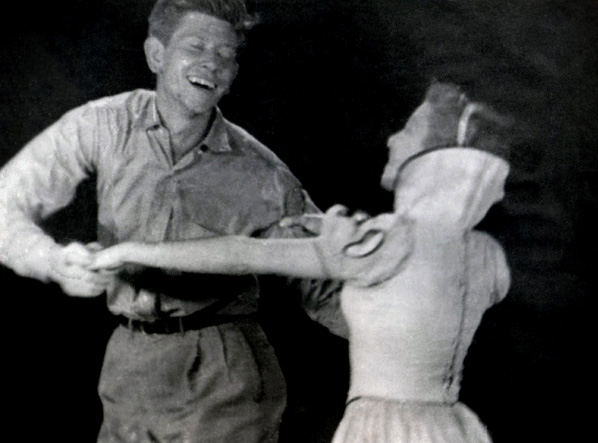Information
Full name: Wilfred Emmons Jackson
Birth: January 24, 1906 in Chicago, Illinois
Death: August 7, 1988 in Balbao Island, Newport Beach, California
Marriage:
Jane Ames February 23, 1929 – December 23, 1987)
Worked at the Disney studio between:
1928 – 1961
Production documents mentioning him:
Story Conference of 11/10/1936: Personalities of the seven dwarfs
Job on Snow White:
Director of sequences 8A, 8B, 8C, 15A, 15B, 16A.
Model for the dwarfs
Back to Main Titles

Meticulate and enthusiastic
Wilfred Jackson was born on January 24, 1906, in Chicago, Illinois, but his family moved early to Glendale, California. He graduated from Glendale High in 1924 and attended Otis Art Institute (now called Otis College of Art and Design) in the 1920s because he was fascinated with cartoons from childhood and convinced his parents to let him study in art school. Jackson approached Walt Disney and offered to pay him to work for him and learn animation. Disney hired Jackson who began washing Oswald old cels, and then painting new ones. He worked his way up very fast to inking, then inbetweening (on Steamboat Willie), a background artist (on Gallopin’ Gaucho), and animation (on The Skeleton dance).
In 1928, Jackson joined Disney Studios one week before the bulk of the staff quit and right before the production of Steamboat Willie (1928). He helped devised a system for synchronizing the music and the onscreen action. He was eventually promoted to director in 1930.
Before he could master a craft, Walt would promote Jackson to a new position. When he finally became an animator, he decided he would ask Walt to animate a whole film himself, which was lunacy at this stage where each film was a collaborative effort. Thankfully, when he said that he would like to handle a whole picture, Walt figure that he meant directing it, and assigned him a new short, which also happened to be the first project for the studio of composer Frank Churchill : The Castaway.
Jackson directed several Academy Award-winning shorts, including The Tortoise and the Hare (1935), The Country Cousin (1936), and The Old Mill (1937), which showcased Disney’s Multiplane Camera. His most celebrated work as a director includes The Band Concert (1935), the first Mickey Mouse short in Technicolor, ranked among the greatest short cartoons of all time.
In 1937, Jackson became a sequence director for Disney’s first full-length animated feature, Snow White and the Seven Dwarfs, marking his significant contribution to animation history. He went on to direct sequences in many major Disney animated features, including Fantasia, Dumbo, and Cinderella.
Throughout the 1950s, Jackson transitioned into television, producing and directing for Disney’s Disneyland series. He suffered a heart attack while directing sequences for Lady and the Tramp in 1953, leading to sporadic work on Disney’s TV shows until his retirement in 1961, although he had already been on leave for two years at the time.
Wilfred Jackson passed away on August 7, 1988, in Balboa Island, Newport Beach, California, United States. He was posthumously named a Disney Legend in 1998.
One of the characteristics of the Disney studio was, none of us tried to keep what we had from anybody else. It was a real team effort. And any of us who had anything that we could impart to another fellow, to help his work be better, we wanted to do. And that went a hundred per cent, all the way through the thing. Everybody wanted to help everybody else make a better picture, which was one of the things that made it such a wonderful place to work.
Wilfred Jackson
